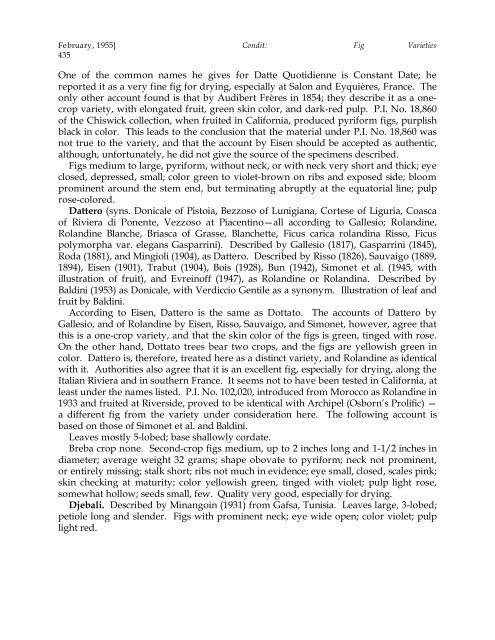Fig Varieties: A Monograph - uri=ucce.ucdavis
Fig Varieties: A Monograph - uri=ucce.ucdavis
Fig Varieties: A Monograph - uri=ucce.ucdavis
Create successful ePaper yourself
Turn your PDF publications into a flip-book with our unique Google optimized e-Paper software.
February, 1955] Condit: <strong>Fig</strong> <strong>Varieties</strong><br />
435<br />
One of the common names he gives for Datte Quotidienne is Constant Date; he<br />
reported it as a very fine fig for drying, especially at Salon and Eyquières, France. The<br />
only other account found is that by Audibert Frères in 1854; they describe it as a onecrop<br />
variety, with elongated fruit, green skin color, and dark-red pulp. P.I. No. 18,860<br />
of the Chiswick collection, when fruited in California, produced pyriform figs, purplish<br />
black in color. This leads to the conclusion that the material under P.I. No. 18,860 was<br />
not true to the variety, and that the account by Eisen should be accepted as authentic,<br />
although, unfortunately, he did not give the source of the specimens described.<br />
<strong>Fig</strong>s medium to large, pyriform, without neck, or with neck very short and thick; eye<br />
closed, depressed, small; color green to violet-brown on ribs and exposed side; bloom<br />
prominent around the stem end, but terminating abruptly at the equatorial line; pulp<br />
rose-colored.<br />
Dattero (syns. Donicale of Pistoia, Bezzoso of Lunigiana, Cortese of Liguria, Coasca<br />
of Riviera di Ponente, Vezzoso at Piacentino—all according to Gallesio; Rolandine,<br />
Rolandine Blanche, Briasca of Grasse, Blanchette, Ficus carica rolandina Risso, Ficus<br />
polymorpha var. elegans Gasparrini). Described by Gallesio (1817), Gasparrini (1845),<br />
Roda (1881), and Mingioli (1904), as Dattero. Described by Risso (1826), Sauvaigo (1889,<br />
1894), Eisen (1901), Trabut (1904), Bois (1928), Bun (1942), Simonet et al. (1945, with<br />
illustration of fruit), and Evreinoff (1947), as Rolandine or Rolandina. Described by<br />
Baldini (1953) as Donicale, with Verdiccio Gentile as a synonym. Illustration of leaf and<br />
fruit by Baldini.<br />
According to Eisen, Dattero is the same as Dottato. The accounts of Dattero by<br />
Gallesio, and of Rolandine by Eisen, Risso, Sauvaigo, and Simonet, however, agree that<br />
this is a one-crop variety, and that the skin color of the figs is green, tinged with rose.<br />
On the other hand, Dottato trees bear two crops, and the figs are yellowish green in<br />
color. Dattero is, therefore, treated here as a distinct variety, and Rolandine as identical<br />
with it. Authorities also agree that it is an excellent fig, especially for drying, along the<br />
Italian Riviera and in southern France. It seems not to have been tested in California, at<br />
least under the names listed. P.I. No. 102,020, introduced from Morocco as Rolandine in<br />
1933 and fruited at Riverside, proved to be identical with Archipel (Osborn’s Prolific) —<br />
a different fig from the variety under consideration here. The following account is<br />
based on those of Simonet et al. and Baldini.<br />
Leaves mostly 5-lobed; base shallowly cordate.<br />
Breba crop none. Second-crop figs medium, up to 2 inches long and 1-1/2 inches in<br />
diameter; average weight 32 grams; shape obovate to pyriform; neck not prominent,<br />
or entirely missing; stalk short; ribs not much in evidence; eye small, closed, scales pink;<br />
skin checking at maturity; color yellowish green, tinged with violet; pulp light rose,<br />
somewhat hollow; seeds small, few. Quality very good, especially for drying.<br />
Djebali. Described by Minangoin (1931) from Gafsa, Tunisia. Leaves large, 3-lobed;<br />
petiole long and slender. <strong>Fig</strong>s with prominent neck; eye wide open; color violet; pulp<br />
light red.
















![Fig Trees in North Carolina [Archive] - IDigMyGarden ... - Figs 4 Fun](https://img.yumpu.com/26905320/1/190x245/fig-trees-in-north-carolina-archive-idigmygarden-figs-4-fun.jpg?quality=85)